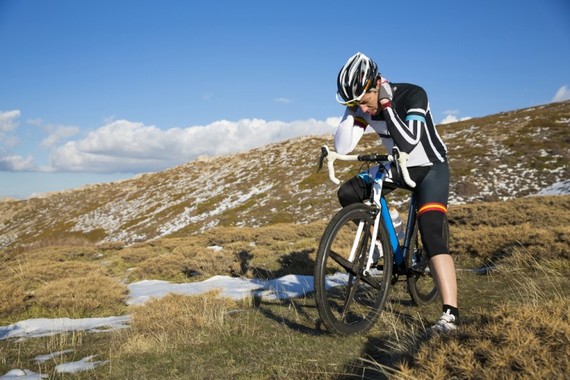We love to ride. The camaraderie of riding in a peloton, or the solo inspiration of riding and day dreaming, keeps us on our bikes for hours. We adjust our diets to get leaner. We drink fluids loaded with carbohydrates. Even the clothes we wear are designed to highlight our slim bodies, while diminishing their wind resistance.
Over time, our fanatical addiction to riding increases. We measure our output in every conceivable way. The bikes get more expensive. The materials get lighter. Sucked in to the vortex of staying in the saddle, updating our gear and becoming "real" cyclists, our other activities fall by the wayside. And therein lays the problem.
My cyclist patients are not always fit. Yes, their aerobic capacity is impressive. Their quads are ever increasing. But watch them when they get off the bike. For the first minute or two, they can barely stand up. Their backs ache. Their necks are sore. Their hips are tight. They look like the classic picture of abused laborers.
So where is the disconnect? Cycling, while great for some parts of the body, is not so good for others. The abdomen hangs down, even if lean, and does not get stronger. The oblique muscles of trunk and core experience the same repetitive motion for hours on end, and become weak in all other planes of motion. The back is curved on the bike, and sees repetitive strain to the lower portion, where the pelvis rocks up and down at the lumbosacral interface. When combined with weak abdominal muscles, the strain on the spine and on the musculature of the trunk leaves the cyclist prone to increased back pain and disc degeneration.[1]
The bones of our bodies build mass according to the amount of force applied to them.[2] This law of bone physics, called Wolfe's Law, comes into play for the cyclist on a rolling bike--for hours on end. Without the impact of walking or the vertical loads of weight training, the bones weaken.
One study [of 27 older (average age 51) and 16 younger (average age 31) competitive cyclists, by Nichols] shows lowered bone mineral density in long-time cyclists, confirming this observation.[3]
And that's not all. While riding the cyclist's neck is extended, with a helmet increasing the weight. The head acts as a lever arm, straining the neck muscles. Add the force of road bumps, and the discs between the vertebral bodies of the cervical spine suffer repeated sudden loads. Want proof? Take a look at cyclists' tense necks when they get off their super-light, super stiff carbon fiber body-abusing machines!
Finally, the knees. The bike is almost always kind to the knees, even the arthritic ones.[4] It is hard to injure the knee on the bike unless you fall off. The tendonitis at the patella or the iliotibial band that we sometimes see is usually easily fixed with better bike fit.
So what is a cyclist to do? Cross train. CROSS TRAIN. Do weight training, PILATES, hiking and Yoga. There is a whole list of fantastic opportunities to increase flexibility, strengthen other muscles and build bone mass--all key to a cyclist's health.
But even more fun than a laser-like focus on cycling is a return to being a multi-sport athlete. Add new sports each year to your activity repertoire. Love the bike -- but leave it more often.
* * *
References
1.Srinivasan, J., and Venkatesh Balasubramanian. "Low back pain and muscle fatigue due to road cycling--An sEMG study." Journal of Bodywork and Movement Therapies 11, no. 3 (2007): 260-266.
2.Frost, Harold M. "A 2003 update of bone physiology and Wolff's Law for clinicians." The Angle Orthodontist 74, no. 1 (2004): 3-15.
3.Nichols, Jeanne F., and Mitchell J. Rauh. "Longitudinal changes in bone mineral density in male master cyclists and nonathletes." The Journal of Strength & Conditioning Research 25, no. 3 (2011): 727-734.
4.Ericson, Mats. "On the biomechanics of cycling. A study of joint and muscle load during exercise on the bicycle ergometer." Scandinavian journal of rehabilitation medicine. Supplement 16 (1985): 1-43.
